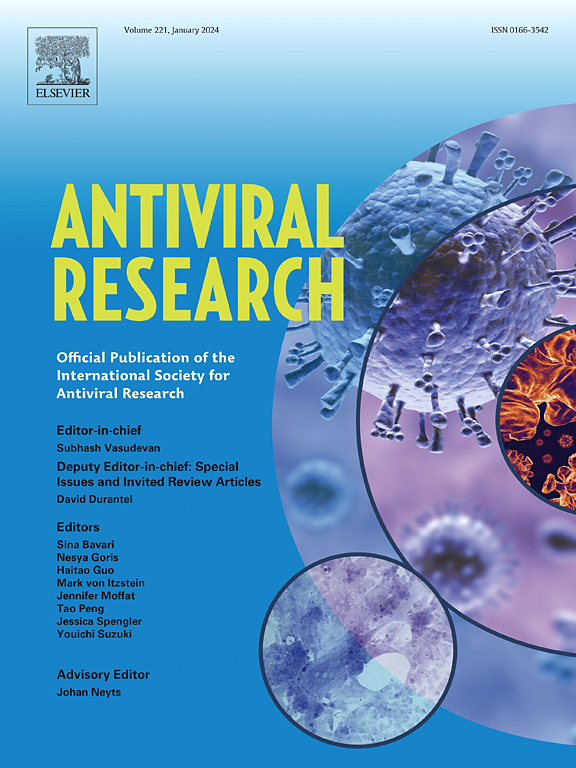Influenza A(H1N1)pdm09 virus resistance to baloxavir, oseltamivir and sialic acid mimetics in single and dual therapies: Insights from human airway epithelia and murine models
IF 4
2区 医学
Q1 PHARMACOLOGY & PHARMACY
引用次数: 0
Abstract
Influenza viruses pose a significant threat due to annual epidemics and pandemic potential. Resistance to current antivirals underscores the need for new drugs and strategies to prevent its emergence. We previously developed two novel HA-targeting compounds (CD-6′SLN and CD-SA) with demonstrated efficacy against influenza A and B strains. Here, we compared their resistance barrier to that of FDA-approved oseltamivir (OS) and baloxavir marboxil (BXM). We established a resistance testing assay in human airway epithelia (HAE) and in mice. We also evaluated the impact of combination therapies on resistance emergence. In HAE, highly reduced inhibition (HRI) by CD-6′SLN and CD-SA occurred within 2 and 4 weeks respectively without fitness loss, while reduced inhibition (RI) by baloxavir acid (BXA) emerged within 4 weeks. No reduction of susceptibility to OS was observed in the same time frame. Of note, emergence of RI by CD-SA was not delayed in BXA/CD-SA co-treatment, and slightly reduced upon OS/CD-SA co-treatment. In mice, RI by CD-SA was observed after 8 passages in one of three mice treated with OS/CD-SA, but not in mice with single therapies. This study demonstrates that (1) HAE represents a relevant model to detect emergence of resistance and (2) HA-targeting compounds are prone to induce resistance followed by BXA and OS. Importantly, combination of clinically available antivirals and HA-targeting compounds did not prevent the emergence of variants with HA substitutions. Additional research is needed to develop anti-influenza antivirals with high resistance barrier and compounds should be tested in HAE before moving to animal experimentation.
甲型H1N1流感(H1N1)pdm09病毒对巴洛韦、奥司他韦和唾液酸模拟物的单药和双药耐药性:来自人气道上皮和小鼠模型的见解
流感病毒由于每年流行和大流行的潜力而构成重大威胁。对当前抗病毒药物的耐药性强调需要新的药物和战略来防止其出现。我们之前开发了两种新的ha靶向化合物(CD-6'SLN和CD-SA),证明它们对甲型和乙型流感病毒有效。在这里,我们将它们的耐药屏障与fda批准的奥司他韦(OS)和巴洛昔韦(BXM)进行了比较。我们在人气道上皮(HAE)和小鼠中建立了一种耐药试验。我们还评估了联合治疗对耐药性出现的影响。在HAE中,CD-6'SLN和CD-SA的抑制作用(HRI)分别在2周和4周内出现高度降低,且没有健康损失,而巴洛韦酸(BXA)的抑制作用(RI)在4周内出现降低。在同一时间段内未观察到对OS的易感性降低。值得注意的是,在BXA/CD-SA共处理中,CD-SA引起的RI的出现没有延迟,在OS/CD-SA共处理中略有减少。在小鼠中,用OS/CD-SA治疗的3只小鼠中有一只在8代后观察到CD-SA引起的RI,但在单次治疗的小鼠中没有观察到。本研究表明:(1)HAE是检测耐药出现的相关模型;(2)ha靶向化合物容易诱导耐药,其次是BXA和OS。重要的是,临床可用的抗病毒药物和HA靶向化合物的组合并不能阻止HA替代变体的出现。开发具有高耐药性屏障的抗流感抗病毒药物需要进一步的研究,在进行动物实验之前,应在HAE中对化合物进行测试。
本文章由计算机程序翻译,如有差异,请以英文原文为准。
求助全文
约1分钟内获得全文
求助全文
来源期刊

Antiviral research
医学-病毒学
CiteScore
17.10
自引率
3.90%
发文量
157
审稿时长
34 days
期刊介绍:
Antiviral Research is a journal that focuses on various aspects of controlling viral infections in both humans and animals. It is a platform for publishing research reports, short communications, review articles, and commentaries. The journal covers a wide range of topics including antiviral drugs, antibodies, and host-response modifiers. These topics encompass their synthesis, in vitro and in vivo testing, as well as mechanisms of action. Additionally, the journal also publishes studies on the development of new or improved vaccines against viral infections in humans. It delves into assessing the safety of drugs and vaccines, tracking the evolution of drug or vaccine-resistant viruses, and developing effective countermeasures. Another area of interest includes the identification and validation of new drug targets. The journal further explores laboratory animal models of viral diseases, investigates the pathogenesis of viral diseases, and examines the mechanisms by which viruses avoid host immune responses.
 求助内容:
求助内容: 应助结果提醒方式:
应助结果提醒方式:


